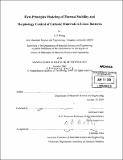| dc.contributor.advisor | Gerbrand Ceder. | en_US |
| dc.contributor.author | Wang, Lei, Ph.D. Massachusetts Institute of Technology | en_US |
| dc.contributor.other | Massachusetts Institute of Technology. Dept. of Materials Science and Engineering. | en_US |
| dc.date.accessioned | 2010-10-29T18:19:22Z | |
| dc.date.available | 2010-10-29T18:19:22Z | |
| dc.date.copyright | 2009 | en_US |
| dc.date.issued | 2010 | en_US |
| dc.identifier.uri | http://hdl.handle.net/1721.1/59711 | |
| dc.description | Thesis (Ph. D.)--Massachusetts Institute of Technology, Dept. of Materials Science and Engineering, February 2010. | en_US |
| dc.description | "October 2009." Cataloged from PDF version of thesis. | en_US |
| dc.description | Includes bibliographical references. | en_US |
| dc.description.abstract | We compute the energy of a large number of oxidation reactions of 3d transition metal oxides using the generalized gradient approximation (GGA) to density functional theory and GGA+ U method. Two substantial contributions to the error in GGA oxidation energies are identified. The first contribution originates from the overbinding of GGA in the O₂ molecule and is only present when the oxidant is O₂. The second error occurs in all oxidation reactions and is related to the correlation error in 3d orbitals in GGA. The constant error in the oxidation energy from the O₂ binding error can be corrected by fitting the formation enthalpy of simple non-transition metal oxides. Removal of the 02 binding error makes it possible to address the correlation effects in 3d transition metal oxides with the GGA+U method. Building on the previous success of obtaining accurate oxidation energies from first-principles calculations, we present a new method for predicting the thermodynamics of thermal degradation of charged cathode materials for rechargeable Li batteries and demonstrate it on three cathode materials, LixNiO₂, LixCoO₂, and LiMn2O₂. The calculated decomposition heat for the three systems is in good agreement with experiments. The electrolyte can act as a sink for the oxygen released from the cathode. Although oxygen release from the cathode is generally endothermic, its combustion with the electrolyte leads to a highly exothermic reaction, which is the main source of safety problems with lithium batteries. This thesis also studies surface properties and morphology control of olivine structure LiMPO₄ (M=Fe, Mn). The calculated surface energies and surface redox potentials are very anisotropic. With the calculated surface energies, we provide the thermodynamic equilibrium shape of a LiMPO₄ crystal under vacuum. We furthermore establish an ab initio approach to study surface adsorption and Li dissolution in aqueous solutions. We demonstrate for LiFePO₄ that ab initio calculations can be used effectively to investigate the crystal shape dependency on practical solution parameters, such as electric potential E and solution pH. Our first-principles work is helpful in finding a synthesis condition that favors the production of platelet shape LiFePO₄ with large area of reaction active (010) surface. | en_US |
| dc.description.statementofresponsibility | by Lei Wang. | en_US |
| dc.format.extent | 157 p. | en_US |
| dc.language.iso | eng | en_US |
| dc.publisher | Massachusetts Institute of Technology | en_US |
| dc.rights | M.I.T. theses are protected by
copyright. They may be viewed from this source for any purpose, but
reproduction or distribution in any format is prohibited without written
permission. See provided URL for inquiries about permission. | en_US |
| dc.rights.uri | http://dspace.mit.edu/handle/1721.1/7582 | en_US |
| dc.subject | Materials Science and Engineering. | en_US |
| dc.title | First-principles modeling of thermal stability and morphology control of cathode materials in Li-ion batteries | en_US |
| dc.type | Thesis | en_US |
| dc.description.degree | Ph.D. | en_US |
| dc.contributor.department | Massachusetts Institute of Technology. Department of Materials Science and Engineering | |
| dc.identifier.oclc | 668434555 | en_US |
